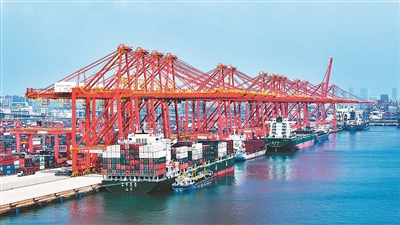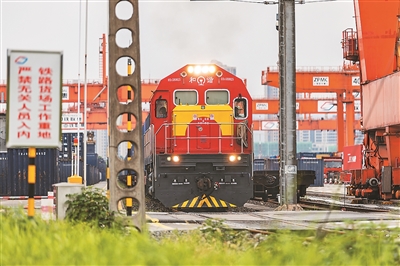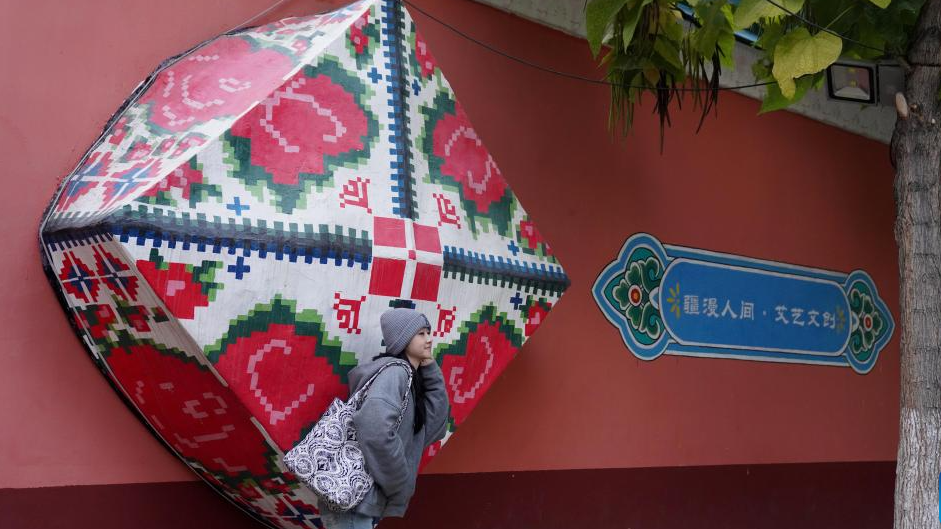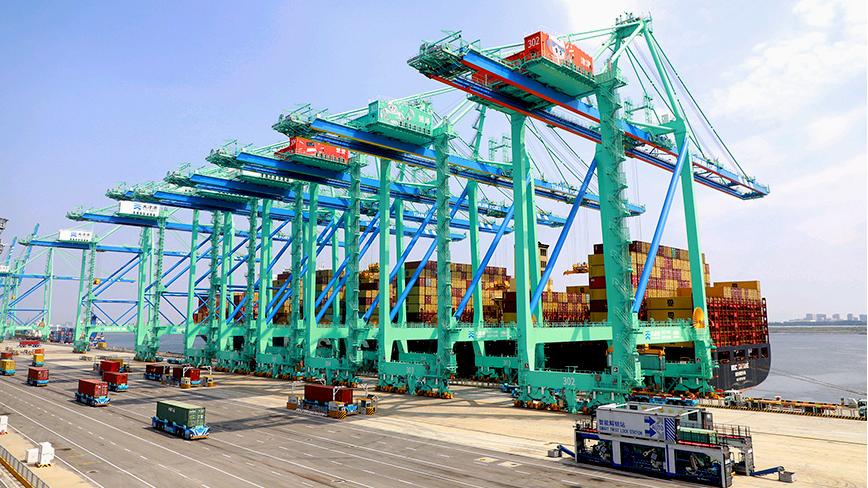Eight major leaps: Witnessing China's economic rise through the numbers
In the 75 years since the founding of the People's Republic of China (PRC), especially since the reform and opening-up launched in 1978, China has continuously explored its own path of opening to the outside world, actively participated in international economic cooperation and competition, and achieved a great historical transformation from being closed or semi-closed to all-round openness. Recently, the National Bureau of Statistics released a report on the 75 years of economic and social development achievements of New China, showcasing the leapfrog development in foreign economic and trade fields since the founding of the PRC.
What achievements has China made in foreign trade over these 75 years? Let's take a look at eight sets of data and eight major leaps.

Photo shows a view of the container terminal of the Rizhao Port in Rizhao city, east China's Shandong Province. (Xinhua/Li Ziheng)
Leap One: From less than 1 percent to 1/8
The share of China's total import and export of goods in the global total increased from less than 1 percent to 1/8.
From muddy beaches, bustling ports have emerged; old narrow-gauge railways have transformed into electrified dual-track lines; and standard shipping containers now stand where once there were only rudimentary cargo yards... Over 75 years, the share of China's total import and export of goods in the global total has risen from less than 1 percent to 1/8, marking an extraordinary leap.
In 1950, China's total import and export of goods was only $1.1 billion, accounting for less than 1 percent of the world's total. Before the reform and opening-up, it was rare for foreigners to see products labeled "Made in China", and imported goods were scarce in the domestic market. Cuban sugar, Iraqi dates, and Albanian cigarettes... these are some of the few memories that the older generation of Chinese people have about imported goods back then.
Since 1978, particularly after joining the World Trade Organization (WTO) in 2001, China has continuously improved its level of opening up, steadily expanding the scale of merchandise trade. In 2013, China became the world's largest merchandise trading nation for the first time. In 2023, China's total import and export of goods reached $5.9 trillion, with a global share rising to 12.4 percent, maintaining the top position for seven consecutive years.
Along the long coastline, mega-ports such as Shanghai, Ningbo-Zhoushan, and Guangzhou connect maritime arteries, supporting more than 30 percent of the world's maritime foreign trade, linking China's super-sized market with the global industrial and supply chains.
In a testament to China's growing trade prowess, the China-Europe freight train service has become a major international transportation artery connecting Asia and Europe. In the first eight months of this year, China-Europe freight trains made 13,000 trips and transported around 1.4 million twenty-foot equivalent units (TEUs) of goods.
Globally, China's prominent position in the cross-border trade landscape has become increasingly evident. From 2013 to 2023, China's annual growth rate of import and export of goods averaged 4 percent, which is 1.6 percentage points higher than the global average during the same period. With a more proactive opening-up strategy, new competitive advantages in foreign trade have been continuously formed, and the status as a major trading nation has been further consolidated.
Leap Two: From less than 20 percent to 95.1 percent
The proportion of manufactured good exports in the total export value increased from less than 20 percent in the early days after the founding of the PRC to 95.1 percent in 2023.
At the beginning of the PRC, the main characteristic of the trade structure was the export of primary products such as agricultural and sideline products in exchange for foreign currency to import machinery and other manufactured goods.
After the reform and opening-up, with the improvement of China's industrial production capacity, the structure of import and export commodities underwent a fundamental change, with its exports shifting from mainly primary products to mainly manufactured goods.
Looking at exports, with the development of science and technology and the continuous progress of productivity, the technological content of China's foreign trade products has continued to increase. Looking at imports, the ratio of China's manufactured goods import value to the import value of primary products dropped from 4.5 times in the 1980s and 1990s to 1.4 times in 2023, with China's imported goods transitioning from a focus on manufactured goods to a balanced development of primary and manufactured goods.
Before, when talking about "Made in China" overseas, it referred to the "old three": home appliances, furniture, and clothing. In recent years, the export scale of the "new three" products—photovoltaic products, electric vehicles, and lithium-ion batteries—has significantly increased. In the first eight months of this year, the export of mechanical and electrical products accounted for nearly 60 percent of the total export value, and the export advantages of cars and integrated circuits continue to be consolidated.
China's exported goods are climbing to the high end of the global industrial and value chains. High technology, high added value, and green low-carbon development have become the new labels of China's export products.
Leap Three: From over 40 countries and regions to more than 230
China's foreign trade partners have expanded from over 40 countries and regions at the beginning of the reform and opening-up to more than 230 countries and regions today.
Behind the smooth flow of cross-border trade is the continuously improving level of trade facilitation between China and more than 230 countries and regions worldwide.
In the early days of the PRC, the main foreign trade partners of China were the Soviet Union and Eastern European socialist countries. At the beginning of the reform and opening-up, China's foreign trade partners had grown to over 40 countries and regions. Since the reform and opening up, especially after joining the WTO, China has actively adapted to the international market situation, continuously deepening economic and trade exchanges with countries around the world, and diversifying its trade partners.
Entering the new era, China has implemented a more proactive and open strategy, continuously pushing for a broader, wider, and deeper level of opening up, making trade relations with various countries closer and expanding the scale of trade with emerging markets.
Today, China's foreign trade partners have expanded to more than 230 countries and regions, and China has become a major trading partner for over 140 countries and regions.
China's imports and exports with partner countries of the Belt and Road Initiative (BRI) hit 19.5 trillion yuan (about $2.78 trillion) in 2023, making up 46.6 percent of the country's total import and export volume, compared to 10.1 trillion yuan in 2013 when the BRI was first put forward.
Leap Four: From over 10 to 645,000
In 1978, there were only over 10 specialized general companies in China engaged in foreign trade business; by 2023, the number of foreign trade entities with actual import and export business reached 645,000.
Before the reform and opening up, China's foreign trade operators were primarily state-owned enterprises, and foreign trade was conducted according to national directive plans, with operating rights managed uniformly by the state. After the reform and opening up, as foreign trade operating rights were liberalized, foreign-invested and private enterprises entered the market.
In 2004, the revised "Foreign Trade Law of the People's Republic of China" changed the management of foreign trade operating rights from an approval system to a registration system, removing the threshold restrictions on foreign trade operating rights, leading to a substantial increase in the number of foreign trade enterprises. In 2019, private enterprises became the main force in the development of China's foreign trade. By 2023, the share of imports and exports by private enterprises in the total import and export volume increased to 53.5 percent, maintaining the position as the largest foreign trade operating entity in China for five consecutive years.
With many ships vying to navigate the vast ocean of the international market, the dynamic Chinese foreign trade entities will continue to forge ahead through the waves.

A China-Europe freight train departs from the Tuanjiecun Station in the Chongqing International Logistics Hub Park in southwest China's Chongqing Municipality. (Xinhua/Huang Wei)
Leap Five: From almost zero to fourth in the world
The scale of China's service trade has grown from almost zero at the beginning of the founding of the PRC to $933.1 billion in 2023, ranking fourth in the world.
Service trade is an important component of international trade and a significant driver of economic globalization. At the beginning of the PRC, China's service trade was virtually non-existent; before the reform and opening up, China's service trade was limited to a small amount of technical assistance abroad and inbound tourism services.
In the early days of the reform and opening up, China's service trade was mainly focused on traditional services such as transportation and travel. In terms of scale, in 1982, China's total service trade import and export value was $4.69 billion, ranking 34th in the world. In terms of structure, in the 1980s, traditional services accounted for more than 80 percent of the total service trade import and export value on average.
From 1983 to 2023, the annual growth rate of China's total service trade imports and exports exceeded the global average by 6.5 percentage points, with its share in the global total service trade steadily increasing.
Since the 18th National Congress of the Communist Party of China, China has actively carried out comprehensive pilot programs for expanding the opening up of the service sector, and the scale of service trade has continuously expanded, reaching $933.1 billion in 2023, ranking fourth in the world.
From nothing to something, from weak to strong, the quality of service trade development has been continuously improving.
Leap Six: From the Canton Fair to the CIIE
The first Canton Fair was attended by only over 10 countries and regions. Today, various exhibitions such as the Canton Fair, the China International Import Expo (CIIE), the China International Fair for Trade in Services (CIFTIS), the China International Consumer Products Expo (CICPE), and the China International Supply Chain Expo (CISCE) have been driving the expansion of China's foreign trade "friend circle".
Large economic and trade fairs like CIFTIS are important channels for foreign trade companies to secure orders. "Reaping rich rewards" is a common sentiment shared by many participating enterprises.
When it comes to China's foreign trade exhibitions, one cannot overlook the Canton Fair. As the longest-running comprehensive international trade fair in China, the Canton Fair is known as "China's No. 1 exhibition". In the spring of 1957, the first Canton Fair attracted more than 1,200 buyers from 19 countries and regions, with a transaction volume exceeding $86 million. The Canton Fair has been held 135 times, establishing trade ties with 229 countries and regions worldwide. Throughout its history, the fair has facilitated approximately $1.5 trillion in export transactions and attracted more than 10 million international buyers, both in-person and online. This "golden brand" of the Canton Fair continues to shine with new era brilliance.
Various large-scale exhibitions continue to develop, becoming important platforms for China to expand its opening up and deepen international cooperation, promoting mutual benefits and win-win outcomes between China and the rest of the world.
According to data from the China Council for the Promotion of International Trade, in 2023, China hosted 3,923 economic and trade exhibitions, a year-on-year increase of 117.1 percent, and an increase of 10.6 percent compared to 2019. These exhibitions have been expanding China's foreign trade "friend circle" continuously.
Leap Seven: From one pilot zone to 22 "experimental fields"
In 2023, the combined import and export value of 22 pilot free trade zones (FTZs) amounted to 7.7 trillion yuan, accounting for 18.4 percent of China's total import and export value.
Establishing FTZs is a significant move in China's efforts to promote reform and opening up. This initiative began in 2013 and was first implemented in Shanghai.
Since the establishment of the Shanghai Free Trade Zone in 2013, China has continuously optimized and improved the layout of FTZs, forming a pattern of reform, opening up, and innovation that covers the east, west, north, south, and central regions, integrating coastal, inland, and border areas:
Over 11 years, China has successively set up 22 pilot FTZs, proactively aligning with international rules in trade, investment, and finance, accumulating rich experience for advancing high-level opening up.
China has deployed over 3,400 reform pilot tasks in the "experimental fields" of FTZs, summarizing and refining seven batches of reform pilot experiences and four batches of best practice cases at the national level, and replicating and promoting over 300 institutional innovation achievements across the country.
A report released by the United Nations Conference on Trade and Development (UNCTAD) noted that China's pilot FTZs adhere to local conditions, highlighting regional characteristics, adopting a phased and gradual approach to enhance the facilitation of investment and trade, promote innovation and technological development, and expand the opening up of key sectors such as services and digital industries, achieving positive results.
Leap Eight: From one framework agreement to 22 free trade agreements
On June 2 last year, the Regional Comprehensive Economic Partnership (RCEP) agreement took effect for all its 15 members.
China's total imports and exports with the other 14 RCEP members reached 12.6 trillion yuan in 2023, representing a 5.3 percent increase from 2021.
The 15 RCEP members account for around 30 percent of the global population, global GDP and global trade, and the full implementation of the RCEP marked the start of a new stage for the trade bloc with the world's largest population and trade volume as well as the greatest development potential, said an official with China's Ministry of Commerce.
By the end of 2023, China had signed 22 free trade agreements (FTAs) with 29 countries and regions.
Photos
Related Stories
- Developing countries can adapt and replicate China's experience, Asian Development Bank official says
- China eyes steady growth amid Fed rate cut
- China develops debut economy to expand high-quality supply
- China's growth helps bolster global economic recovery in H1
- China reports growth in the consumer economy
Copyright © 2024 People's Daily Online. All Rights Reserved.









